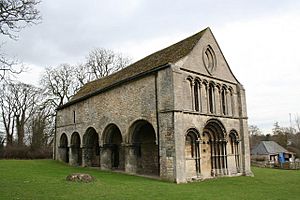St Leonard's Priory, Stamford facts for kids
St Leonard's Priory, Stamford was a special kind of religious building called a priory in Lincolnshire, England. A priory is like a home for monks or nuns who live together and dedicate their lives to religious study and prayer. This priory was built in a town called Stamford. People believe it was built on the very spot where an even older monastery stood, founded by a saint named Wilfrid way back in 658 AD. Sadly, that first building was destroyed during a time when Danish invaders attacked England.
The priory you see today was started again around 1082. Two important people helped make this happen: William the Conqueror, who was the King of England, and William de St-Calais, who was the Bishop of Durham. A bishop is a high-ranking leader in the Christian church. St Leonard's Priory stayed connected to Durham Cathedral (a very large church) until it was closed down in 1538. This closing was part of a big event in English history called the Dissolution of the Monasteries, when many religious houses were shut down by the king.
Even today, you can still see parts of the old church building. The western front and some of the northern arches show a beautiful style of building called transitional Norman architecture. These ruins are very important! The site of St Leonard's Priory is protected as a Scheduled Monument, which means it's a nationally important historical site. The remaining structure is also a Grade I listed building, which is the highest level of protection for historic buildings in England.
Contents
What is a Priory?
A priory is a type of monastery. It's a place where monks or nuns live together under religious rules. They spend their days in prayer, study, and work. Priories were very important in medieval times. They often had farms, libraries, and even schools. They played a big role in their local communities.
A Long History
St Leonard's Priory has a very long story, going back over a thousand years!
The First Monastery
The very first religious building on this spot was thought to be a monastery founded by Wilfrid, a famous saint, in 658 AD. This was during the time of the Anglo-Saxons in England. It was a place for early Christians to live and worship.
Danish Invasion
Sadly, this first monastery didn't last forever. It was destroyed during the Danish invasion of England. This was a time when Viking warriors from Denmark attacked and took over parts of England. Many towns and religious buildings were damaged or destroyed during these invasions.
The Priory is Rebuilt
After the destruction, the site was empty for many years. But around 1082, the priory was started again. This was a big deal because two very powerful people helped:
- William the Conqueror: He was the King of England, having conquered the country in 1066.
- William de St-Calais: He was the Bishop of Durham, an important church leader.
They worked together to rebuild St Leonard's Priory. It became a "cell" of Durham Cathedral. This means it was a smaller religious house that was controlled by the much larger and more important cathedral in Durham.
The Priory Closes Down
St Leonard's Priory continued to operate for hundreds of years. Monks lived there, prayed, and worked. But in 1538, a major change happened in England.
The Dissolution of the Monasteries
King Henry VIII decided to close down all the monasteries and priories in England. This event is known as the Dissolution of the Monasteries. The king took their lands and wealth. Because of this, St Leonard's Priory, like many others, was shut down. Its monks had to leave, and the buildings were often left to fall into ruin or were taken apart for their stone.
What Remains Today
Even though the priory was closed centuries ago, parts of it still stand. These ruins are important clues to the past.
Architectural Style
The parts of the church that remain show a special building style called transitional Norman architecture. This means it was built during a time when the older, heavy Norman style was starting to change into the lighter, more detailed Gothic style. You can see strong, rounded arches typical of Norman buildings.
Protected Site
The ruins and the land around St Leonard's Priory are very important.
- Scheduled Monument: This means the site is protected by the government because of its national historical importance. It's illegal to damage or alter it without special permission.
- Grade I listed building: The remaining structure is given the highest level of protection for historic buildings. This means it's considered to be of exceptional interest.
These protections help make sure that future generations can also learn from and appreciate this ancient site.



